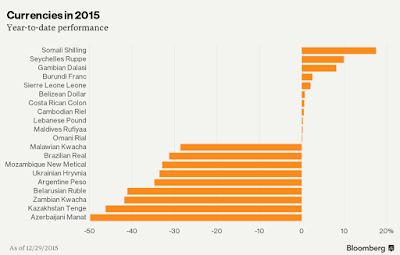Having Russian PMIs for December 2015 allows us to take a look at the economy quarterly performance signals. As noted in the previous post (http://trueeconomics.blogspot.ie/2016/01/4116-russia-services-manufacturing-pmis.html) with the decline in output reflected across both manufacturing production and services activity, Russian economy’s composite PMI averaged 49.1 in 4Q 2015 which is much worse than 50.4 average for 3Q 2015, suggesting that not only did the economy failed to attain stabilisation, but that growth might have turned more negative in 4Q 2015.
Let’s take a closer look at the quarterly averages by sector.
Russian Manufacturing PMI for 4Q 2015 stood at 49.7, which is a gain on 48.4 in 3Q 2015 and marks the strongest quarterly reading since 4Q 2014, but also marks the fourth consecutive quarter of sub-50 readings. The weaknesses in Manufacturing are especially troubling, as the sector is broadly targeted for imports substitution - a major policy shift by the Government since the start of 2015. Making matters worse, the sector should have benefited from strong ruble depreciation over the last 12 months, which - as it appears so far - did not lead to substantial increase in exporting activity. In part, this reflects weaknesses in global demand, but in part it reflects structural problems in Russian manufacturing that find goods supplied by the sector of generally non-competitive quality for global markets, even amidst improved price competitiveness.
Overall, we now have four consecutive quarters of sub-50 readings in Manufacturing sector - for the first time since 3Q 2008-1Q 2009 period.
Russian Services PMI for 4Q 2015 stood at 48.5, down sharply on 50.7 reading in 3Q 2015 and marking the weakest reading in the series since the start of 2Q 2015.Disappointingly, 4Q reading for Services sector broke two consecutive quarters of above 50 readings and done so sharply. Since the start of 1Q 2014, the sector has now posted sub-50 readings in 5 out of 8 quarters, and it managed to post statistically significant readings above 50 in only two quarters.
The above has meant that the composite activity index (distinct from Composite PMI) for Russian stood at 93.9 in 4Q 2015, which is an improvement on 90.3 in 3Q 2015, but marks fifth consecutive quarter of the overall production growth being negative (across combined services and manufacturing sectors). While 4Q composite indicator was the strongest in three quarters, it remains extremely weak (statistically significantly below zero growth marker of 100) and the third weakest of all quarters since the start of 3Q 2009.
On the net, therefore, while Russian economy posted some 4Q signals of growth consistent with less sharp contraction across combined Services and Manufacturing sectors, than in 2Q-3Q 2015, the deterioration in growth conditions in the economy in 4Q 2015 remained pronounced and this strongly suggests that we did not witness stabilisation of the Russian economy in 4Q 2015.
Stay tuned for analysis of BRIC PMIs next.















